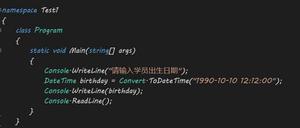C语言实现时间戳转日期的算法(推荐)
1、算法
时间是有周期规律的,4年一个周期(平年、平年、平年、闰年)共计1461天。Windows上C库函数time(NULL)返回的是从1970年1月1日以来的毫秒数,我们最后算出来的年数一定要加上这个基数1970。总的天数除以1461就可以知道经历了多少个周期;总的天数对1461取余数就可以知道剩余的不足一个周期的天数,对这个余数进行判断也就可以得到月份和日了。
当然了,C语言库函数:localtime就可以获得一个时间戳对应的具体日期了,这里 主要说的是实现的一种算法。
2、C语言代码实现
int nTime = time(NULL);//得到当前系统时间
int nDays = nTime/DAYMS + 1;//time函数获取的是从1970年以来的毫秒数,因此需要先得到天数
int nYear4 = nDays/FOURYEARS;//得到从1970年以来的周期(4年)的次数
int nRemain = nDays%FOURYEARS;//得到不足一个周期的天数
int nDesYear = 1970 + nYear4*4;
int nDesMonth = 0, nDesDay = 0;
bool bLeapYear = false;
if ( nRemain<365 )//一个周期内,第一年
{//平年
}
else if ( nRemain<(365+365) )//一个周期内,第二年
{//平年
nDesYear += 1;
nRemain -= 365;
}
else if ( nRemain<(365+365+365) )//一个周期内,第三年
{//平年
nDesYear += 2;
nRemain -= (365+365);
}
else//一个周期内,第四年,这一年是闰年
{//润年
nDesYear += 3;
nRemain -= (365+365+365);
bLeapYear = true;
}
GetMonthAndDay(nRemain, nDesMonth, nDesDay, bLeapYear);
计算月份和日期的函数:
static const int MON1[12] = {31, 28, 31, 30, 31, 30, 31, 31, 30, 31, 30, 31}; //平年
static const int MON2[12] = {31, 29, 31, 30, 31, 30, 31, 31, 30, 31, 30, 31}; //闰年
static const int FOURYEARS = (366 + 365 +365 +365); //每个四年的总天数
static const int DAYMS = 24*3600; //每天的毫秒数
void GetMonthAndDay(int nDays, int& nMonth, int& nDay, bool IsLeapYear)
{
int *pMonths = IsLeapYear?MON2:MON1;
//循环减去12个月中每个月的天数,直到剩余天数小于等于0,就找到了对应的月份
for ( int i=0; i<12; ++i )
{
int nTemp = nDays - pMonths[i];
if ( nTemp<=0 )
{
nMonth = i+1;
if ( nTemp == 0 )//表示刚好是这个月的最后一天,那么天数就是这个月的总天数了
nDay = pMonths[i];
else
nDay = nDays;
break;
}
nDays = nTemp;
}
}
3、附上C语言库函数的实现
<pre name="code" class="cpp">/***
*errno_t _gmtime32_s(ptm, timp) - convert *timp to a structure (UTC)
*
*Purpose:
* Converts the calendar time value, in 32 bit internal format, to
* broken-down time (tm structure) with the corresponding UTC time.
*
*Entry:
* const time_t *timp - pointer to time_t value to convert
*
*Exit:
* errno_t = 0 success
* tm members filled-in
* errno_t = non zero
* tm members initialized to -1 if ptm != NULL
*
*Exceptions:
*
*******************************************************************************/
errno_t __cdecl _gmtime32_s (
struct tm *ptm,
const __time32_t *timp
)
{
__time32_t caltim;/* = *timp; *//* calendar time to convert */
int islpyr = 0; /* is-current-year-a-leap-year flag */
REG1 int tmptim;
REG3 int *mdays;/* pointer to days or lpdays */
struct tm *ptb = ptm;
_VALIDATE_RETURN_ERRCODE( ( ptm != NULL ), EINVAL )
memset( ptm, 0xff, sizeof( struct tm ) );
_VALIDATE_RETURN_ERRCODE( ( timp != NULL ), EINVAL )
caltim = *timp;
_VALIDATE_RETURN_ERRCODE_NOEXC( ( caltim >= _MIN_LOCAL_TIME ), EINVAL )
/*
* Determine years since 1970. First, identify the four-year interval
* since this makes handling leap-years easy (note that 2000 IS a
* leap year and 2100 is out-of-range).
*/
tmptim = (int)(caltim / _FOUR_YEAR_SEC);
caltim -= ((__time32_t)tmptim * _FOUR_YEAR_SEC);
/*
* Determine which year of the interval
*/
tmptim = (tmptim * 4) + 70; /* 1970, 1974, 1978,...,etc. */
if ( caltim >= _YEAR_SEC ) {
tmptim++; /* 1971, 1975, 1979,...,etc. */
caltim -= _YEAR_SEC;
if ( caltim >= _YEAR_SEC ) {
tmptim++; /* 1972, 1976, 1980,...,etc. */
caltim -= _YEAR_SEC;
/*
* Note, it takes 366 days-worth of seconds to get past a leap
* year.
*/
if ( caltim >= (_YEAR_SEC + _DAY_SEC) ) {
tmptim++; /* 1973, 1977, 1981,...,etc. */
caltim -= (_YEAR_SEC + _DAY_SEC);
}
else {
/*
* In a leap year after all, set the flag.
*/
islpyr++;
}
}
}
/*
* tmptim now holds the value for tm_year. caltim now holds the
* number of elapsed seconds since the beginning of that year.
*/
ptb->tm_year = tmptim;
/*
* Determine days since January 1 (0 - 365). This is the tm_yday value.
* Leave caltim with number of elapsed seconds in that day.
*/
ptb->tm_yday = (int)(caltim / _DAY_SEC);
caltim -= (__time32_t)(ptb->tm_yday) * _DAY_SEC;
/*
* Determine months since January (0 - 11) and day of month (1 - 31)
*/
if ( islpyr )
mdays = _lpdays;
else
mdays = _days;
for ( tmptim = 1 ; mdays[tmptim] < ptb->tm_yday ; tmptim++ ) ;
ptb->tm_mon = --tmptim;
ptb->tm_mday = ptb->tm_yday - mdays[tmptim];
/*
* Determine days since Sunday (0 - 6)
*/
ptb->tm_wday = ((int)(*timp / _DAY_SEC) + _BASE_DOW) % 7;
/*
* Determine hours since midnight (0 - 23), minutes after the hour
* (0 - 59), and seconds after the minute (0 - 59).
*/
ptb->tm_hour = (int)(caltim / 3600);
caltim -= (__time32_t)ptb->tm_hour * 3600L;
ptb->tm_min = (int)(caltim / 60);
ptb->tm_sec = (int)(caltim - (ptb->tm_min) * 60);
ptb->tm_isdst = 0;
return 0;
}
以上这篇C语言实现时间戳转日期的算法(推荐)就是小编分享给大家的全部内容了,希望能给大家一个参考,也希望大家多多支持。
以上是 C语言实现时间戳转日期的算法(推荐) 的全部内容, 来源链接: utcz.com/z/325463.html



